Co-authored with “Hidden Opportunities”
Healthcare is a Critical Requirement
Over 131 million people (66% of all adults) in the United States use prescription drugs. The utilization of prescribed medication is exceptionally high for older people and those with chronic conditions. The U.S. population continues to age; over 1 in 6 Americans are now aged 65 or higher, making health care an essential industry.
Medical expenses are inelastic during both bull and bear markets, as individuals consistently prioritize maintaining their doctor appointments and prescription drug needs. National health spending is projected to reach $6.8 trillion in 2030.
Tailwinds From America’s Aging Population
Healthcare is critical to the U.S. economy, as all baby boomers will be over 65 by 2030. This generation, with +76 million people making up ~21% of the U.S. population, will significantly contribute to the nation’s healthcare spending.
Healthcare costs have significantly outpaced inflation over the long term, and the trend will continue in the future, supported by America’s aging population. Source
Health System Tracker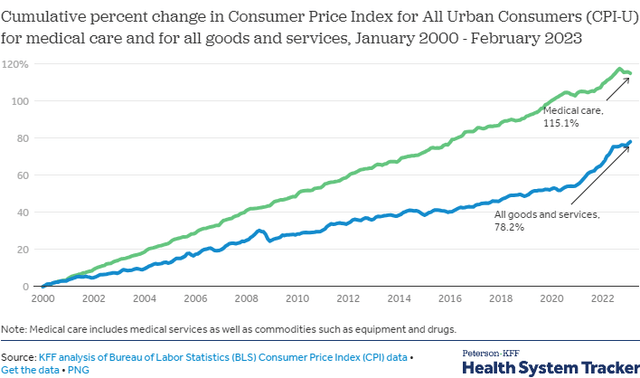
A Difficult Industry for the Average Investor
Despite its attractiveness, the healthcare industry isn’t the easiest to understand and invest due to:
-
Long and highly regulated drug and therapy trial pipeline and approval process
-
Expensive lawsuits and penalties faced by pharma companies
-
Drug patent expirations and competition from generic brands
-
Requirement of subject matter knowledge to understand the treatment effectiveness and the market potential
We want healthcare experts to manage our portfolio while producing reliable income for our retirement needs. We like the Closed-End Funds (‘CEF’) from Tekla Capital Management for their primary emphasis on current income.
Recent Developments in Tekla Capital Management
Global investment company abrdn (fka Aberdeen) has entered into an agreement to acquire the healthcare fund management capabilities of Tekla Capital Management, and the deal includes four healthcare and biotech CEFs totaling US$3 billion in assets under management (‘AUM’). This doesn’t change our opinion on Tekla funds for our long-term income prospects since Tekla’s investment team is joining abrdn as part of the deal. The Tekla team is a group of qualified healthcare professionals and practitioners with an impressive track record of +20 years of investing in the healthcare sector. This strategic acquisition is intended to allow abrdn to build out its healthcare portfolio while drawing from Tekla’s expertise.
Notably, abrdn is globally the third largest CEF manager with AUM over GBP 24.2 billion in U.S. and U.K. listed closed-end funds. abrdn’s expertise in income generation and strong track record through varying market conditions is notable and will benefit the investors of Tekla funds.
Let us now dive into the two healthcare picks that highlight the income method.
Pick #1: THW – Yield 10%
Tekla World Healthcare Fund (THW) is a non-diversified CEF that invests in healthcare with the objective of generating current income and long-term capital appreciation through investments within healthcare.
THW differentiates itself from other Tekla CEFs by making investments across the capital structure of healthcare companies. It holds significant investments in fixed-income securities (preferred stock and bonds). The CEF also has significant assets (>40% of its managed assets) in companies that do considerable business outside the United States. Source
Tekla cap website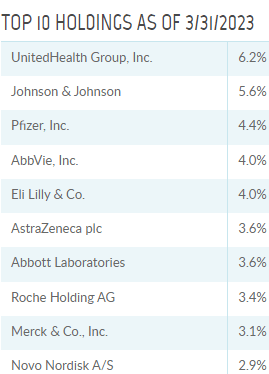
Investors may be concerned about the level of Return of Capital (‘ROC’) in THW’s distributions. Firstly, ROC is not an economic concept but a tax concept. The article by Eaton Vance – Return of Capital Distributions Demystified, is a recommended read for all income investors. There is a big difference between ROC and the return of principal.
Author’s Calculations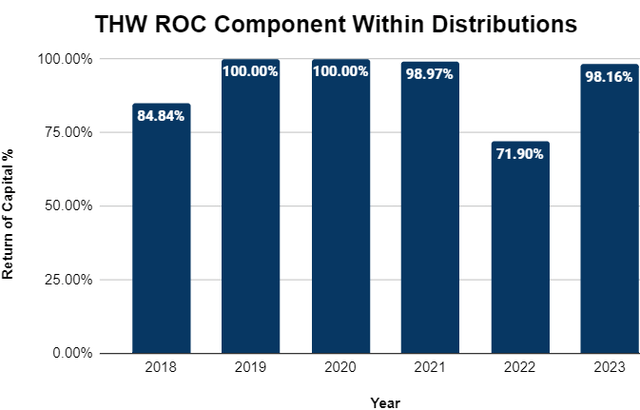
Secondly, THW paid ~$11/share since its inception in 2015. This compares to the $5.85 paper loss in book value. This loss is temporary; THW is well-positioned to see price appreciation as the U.S. economy moves on from these transitory high-interest rates.
THW has matched or outperformed the benchmark healthcare index (S&P Biotech Index) and the broader market (S&P 500) while filling investor’s pockets with reliable income in the past five years, making it an excellent healthcare-focused fund for income investors.
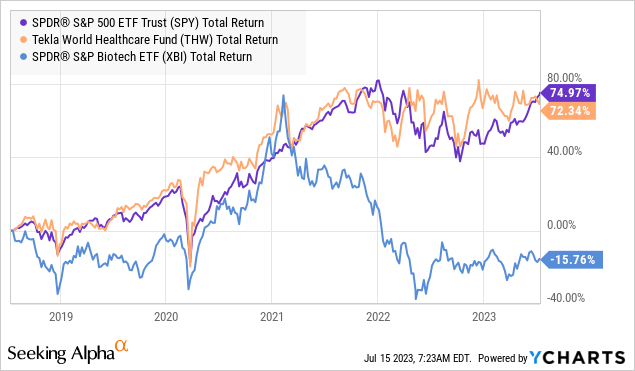
The $0.1167/share monthly distribution calculates to a 10% annualized yield that you should lock in while the market concentrates on near-term challenges.
Pick #2: HQH – Yield 9.3%
Tekla Healthcare Investors (HQH) is a CEF with assets diversified across 150 holdings, with the biopharma and biotechnology sector representing ~80% of the fund. Source
HQH Q1 Fact Card
HQH trades at a ~13% discount to NAV, representing one of the deepest discount levels in the past ten years. Remember that HQH does not employ leverage in its investment strategy and is well-positioned to participate in market recovery while paying growing distributions to shareholders.

HQH has a variable distribution policy where the fund pays out 2% of NAV every quarter. Due to this, when the fund’s NAV declines, investors see a reduction in distributions which inherently protects the fund against asset liquidation at weak prices. When NAV rises, HQH raises its distributions automatically – the process is transparent and easy to calculate. Investors don’t have to hope for a raise or time the market to realize capital gains.
Since our initial buy-alert in 2016, HQH has seen rising and falling NAV and subsequent distributions. Yet, employing our 25% income reinvestment approach, the fund has sustainably and reliably produced income for our requirements. For a $10,000 investment, we see an average annual income of $756. Source
Portfolio Visualizer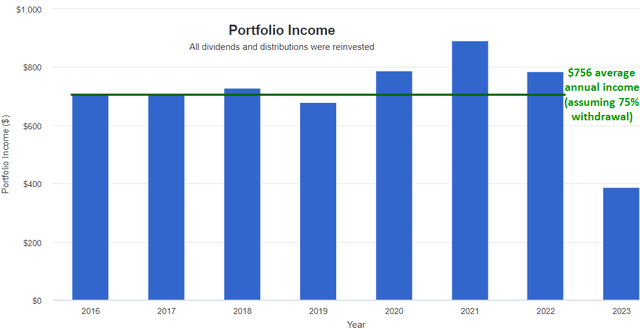
You can lock in an even bigger income stream at today’s discounted prices, with the annual yield calculating 9.3%.
Conclusion
The importance of healthcare to the United States economy cannot be overstated. As America’s population ages, the demand for healthcare services and corresponding spending will attain record levels. The older population often has more frequent medical care needs, chronic disease management, prescription medication, and long-term care, leading to increased healthcare system utilization.
We will see soaring demand for healthcare products and services, making this a robust sector to hold in a retirement portfolio to capture the tailwinds from growing recession-resistant spending. At High Dividend Opportunities, we follow the Income Method, which involves buying attractively-priced securities and getting paid to wait for the tailwinds to strike, or the catalysts to act. No matter how attractive an industry is, we invest only if it pays us for our time (and money). THW and HQH represent the income method of investing in this critical industry while collecting +9% yields. These only represent a tiny fraction of our highly diversified “model portfolio” that houses +45 securities targeting an overall yield of +9%.
HQH and THW are powerful prescriptions for investors seeking solid passive income from the robust tailwind generated by the aging American population. I am honored to be compensated for investing in the extension of America’s lifeline, where every dollar allocated plays a vital role in shaping the future of treatments, procedures, medication, care, and the well-being of countless lives.
Read the full article here








